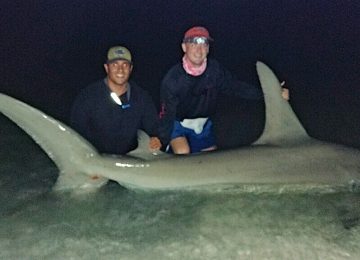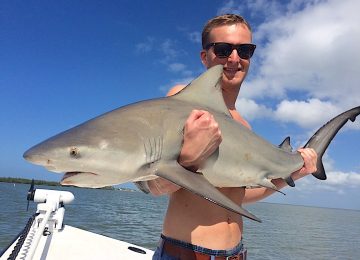
Sanibel Fishing & Captiva Fishing, Hammerhead Shark.

Sanibel Fishing & Captiva Fishing, Captiva Island, Friday, June 2: Hammerhead Sharks, including Great Hammerhead Sharks, are found following and feeding on tarpon, during the summer, particularly in Boca Grande Pass; here’s the latest Red Tide Report (summary: no red tide); for more fishing reports from other areas and Captains, please also visit the Sanibel, Fort Myers, Florida Fishing Report and Cuban Fishing sites. Better water & fishing on the tide changes moving north of Sanibel up through Captiva & North Captiva.
Please click here to Book A Charter or call 239-472-8658 and here for Live Sanibel Traffic Cams. Blacknose Shark, Thursday, May 25; click here for College Of Fishing Hats & Apparel.
We’re located at Castaways Marina, Santiva, Sanibel Island, just before the Blind Pass bridge to Captiva Island.
“The hammerhead sharks are a group of sharks in the family Sphyrnidae, so named for the unusual and distinctive structure of their heads, which are flattened and laterally extended into a “hammer” shape called a cephalofoil. Most hammerhead species are placed in the genus Sphyrna while the winghead shark is placed in its own genus, Eusphyra. Many not necessarily mutually exclusive functions have been proposed for the cephalofoil, including sensory reception, maneuvering, and prey manipulation.

Hammerheads are found worldwide in warmer waters along coastlines and continental shelves. Unlike most sharks, hammerheads usually swim in schools during the day, becoming solitary hunters at night. Some of these schools can be found near Malpelo Island in Colombia, Cocos Island off Costa Rica, and near Molokai in Hawaii. Large schools are also seen in the waters off southern and eastern Africa.
The known species range from 0.9 to 6 m (3.0 to 19.7 ft) in length and weigh from 3 to 580 kg (6.6 to 1,278.7 lb).[2][3] They are usually light gray and have a greenish tint. Their bellies are white which allows them to blend into the ocean when viewed from the bottom and sneak up on their prey.[4] Their heads have lateral projections which give them a hammer-like shape.

Hammerheads have disproportionately small mouths and seem to do a lot of bottom-hunting. They are also known to form schools during the day, sometimes in groups of over 100. In the evening, like other sharks, they become solitary hunters. National Geographic explains that hammerheads can be found in warm tropical waters, but during the summer hammerheads participate in a mass migration to search for cooler waters.[5]
The theory has been advanced that the hammer-like shape of the head may have evolved (at least in part) to enhance the animal’s vision.[8] The positioning of the eyes, mounted on the sides of the shark’s distinctive hammer head, gives the shark good 360-degree vision in the vertical plane, meaning they can see above and below them at all times.[9][10] The shape of the head was previously thought to help the shark find food, aiding in close-quarters maneuverability and allowing sharp turning movement without losing stability.

However, it has been found that the unusual structure of its vertebrae was instrumental in making the turns correctly, more often than the shape of its head, though it would also shift and provide lift. From what is known about the winghead shark, it would appear that the shape of the hammerhead has to do with an evolved sensory function. Like all sharks, hammerheads have electroreceptory sensory pores called ampullae of Lorenzini. By distributing the receptors over a wider area, like a larger radio antenna, hammerheads can sweep for prey more effectively.[11]

Reproduction occurs only once a year for hammerhead sharks and usually occurs with the male shark biting the female shark violently until she agrees to mate with him.[12] The hammerhead sharks exhibit a viviparous mode of reproduction with females giving birth to live young. Like other sharks, fertilization is internal with the male transferring sperm to the female through one of two intromittent organs called claspers.

The developing embryos are at first sustained by a yolk sac. When the supply of yolk is exhausted, the depleted yolk sac transforms into a structure analogous to a mammalian placenta (called a “yolk sac placenta” or “pseudo placenta”), through which the mother delivers sustenance until birth. Once the baby sharks are born, they are not taken care of by the parents in any way. There is usually a litter of 12 to 15 pups; except for the Great Hammerhead which gives birth to litters of 20 to 40 pups. These baby sharks huddle together and swim toward warmer water until they are old enough and large enough to survive on their own.[12]
In 2007, the bonnethead shark was found to be capable of asexual reproduction via automictic parthenogenesis, in which a female’s ovum fuses with a polar body to form a zygote without the need for a male. This was the first shark known to do this.[13]

Hammerhead sharks are known to eat a large range of prey including fish, squid, octopus, crustaceans, and other sharks. Stingrays are a particular favorite. These sharks are often found swimming along the bottom of the ocean, stalking their prey. Their unique head is used as a weapon when hunting down prey. The hammerhead shark uses its head to pin down stingrays and eats the ray when the ray is weak and in shock.[12] The great hammerhead, tending to be larger and more aggressive than most hammerheads, occasionally engages in cannibalism, eating other hammerhead sharks, including its own young.[14]
Of the nine known species of hammerhead, only three are known to be particularly dangerous to humans: the scalloped, great, and smooth hammerheads. As of 2013, 33 attacks have been recorded, with no fatalities.

The great and the scalloped hammerheads are listed on the World Conservation Union’s (IUCN) 2008 Red List as endangered, whereas the smalleye hammerhead is listed as vulnerable. The status given to these sharks is as a result of overfishing and demand for their fins, an expensive delicacy. Among others, scientists expressed their concern about the plight of the scalloped hammerhead at the American Association for the Advancement of Science annual meeting in Boston, Massachusetts. The young swim mostly in shallow waters along shores all over the world to avoid predators.
Shark fins are prized as a delicacy in certain countries in Asia (such as China), and overfishing is putting many hammerhead sharks at risk of extinction. Fishermen who harvest the animals typically cut off the fins and toss the remainder of the fish, which is often still alive, back into the sea.[25] This practice, known as finning, is lethal to the shark.

In Native Hawaiian culture, sharks are considered to be gods of the sea, protectors of humans, and cleaners of excessive ocean life. Some of these sharks are believed to be family members who died and have been reincarnated into shark form. However, some sharks are considered man-eaters, also known as niuhi. These sharks include great white sharks, tiger sharks, and bull sharks.
The hammerhead shark, also known as mano kihikihi, is not considered a man-eater or niuhi; it is considered to be one of the most respected sharks of the ocean, an aumakua. Many Hawaiian families believe that they have an aumakua watching over them and protecting them from the niuhi. The hammerhead shark is thought to be the birth animal of some children. Hawaiian children who are born with the hammerhead shark as an animal sign are believed to be warriors and are meant to sail the oceans. It is extremely rare for hammerhead sharks to pass through the waters of Maui, but many Maui natives believe that hammerhead sharks swimming by is a sign that the gods are watching over the families, and the oceans are clean and balanced.[26]” More background here.

We’re big advocates of catch and release, particularly for snook, but pretty much for most species. Only take what you are going to eat, and a lot of fish are better off as sportfish, even if they are in season. Our motto is let ‘em get bigger and catch ‘em again!
Please click calendar at upper right or call 239-472-8658 to book a charter.
If you had a good time fishing with Captain Joey Burnsed on a Sanibel & Captiva charter, please post an “excellent” review on Google Places, TripAdvisor, Yelp, or Facebook! If you had any issues at all with your charter, please let us know immediately and we’ll do everything we can to make it right! Huge thanks for doing this!
And you can like us on Facebook.
Fair winds and following seas,
Captain Joey Burnsed ~ please click calendar at the upper left or call 239-472-8658 to book a Sanibel & Captiva Islands, Boca Grande or Fort Myers fishing guide trip or shelling charter.
![Hogfish or Hog Snapper, Sanibel Fishing & Captiva Fishing, Sanibel Island, Sunday, December 10, 2017, [File Photo - Wednesday, February 8, 2017].](https://captivafishing.net/wp-content/uploads/wordpress-popular-posts/13104-featured-360x260.jpg)

![Hogfish or Hog Snapper, Sanibel Fishing & Captiva Fishing, Sanibel Island, Sunday, December 10, 2017, [File Photo - Wednesday, February 8, 2017].](https://captivafishing.net/wp-content/uploads/wordpress-popular-posts/11558-featured-360x260.jpg)







![Goliath grouper, Sanibel & Captiva Islands & Fort Myers Charters & Fishing Guide Service, Thursday, November 2, 2017, [August 16, 2012].](https://captivafishing.net/wp-content/uploads/wordpress-popular-posts/11711-featured-360x260.jpg)



![Hogfish or Hog Snapper, Sanibel Fishing & Captiva Fishing, Sanibel Island, Sunday, December 10, 2017, [File Photo - Wednesday, February 8, 2017].](https://captivafishing.net/wp-content/uploads/wordpress-popular-posts/11143-featured-360x260.jpg)





![Schoolmaster Snapper, Sanibel Fishing & Captiva Fishing, Sanibel Island, Thursday, January 11, 2018, [File Photo - Thursday, December 28, 2017].](https://captivafishing.net/wp-content/uploads/wordpress-popular-posts/13203-featured-360x260.jpg)





















You must be logged in to post a comment.